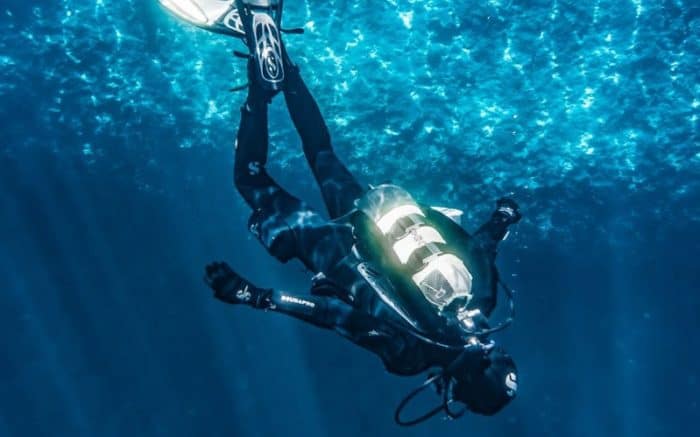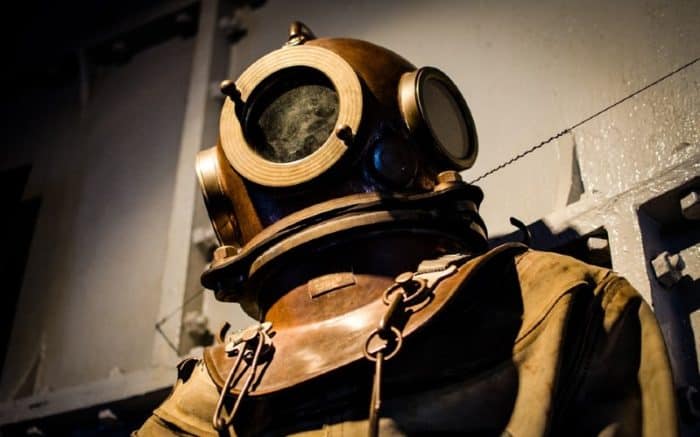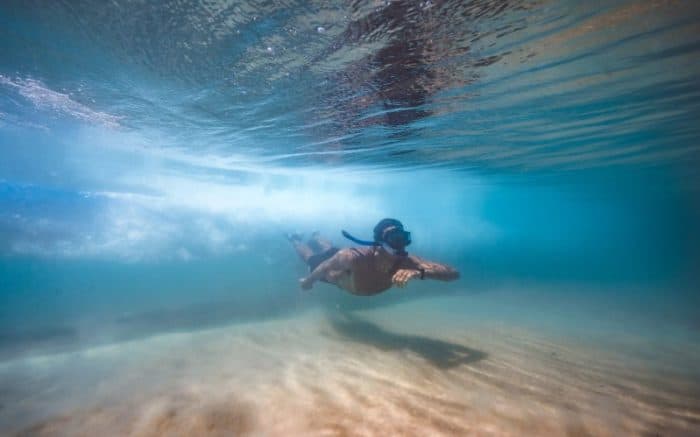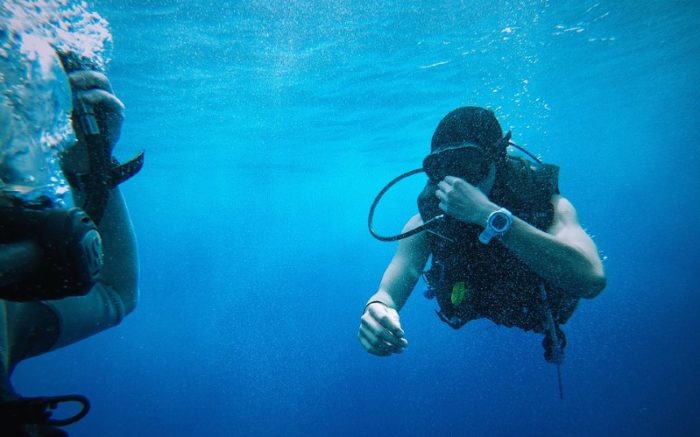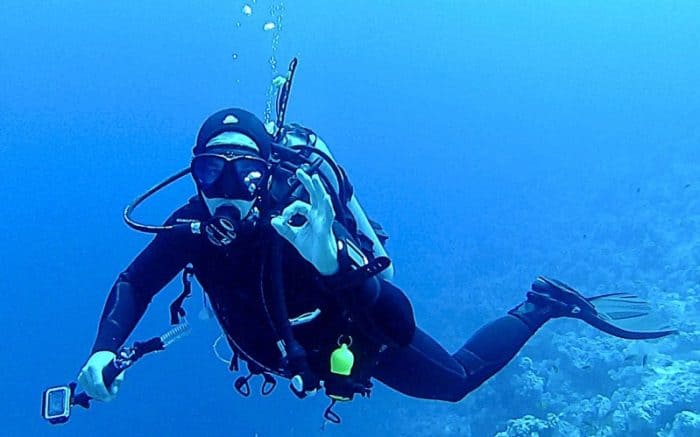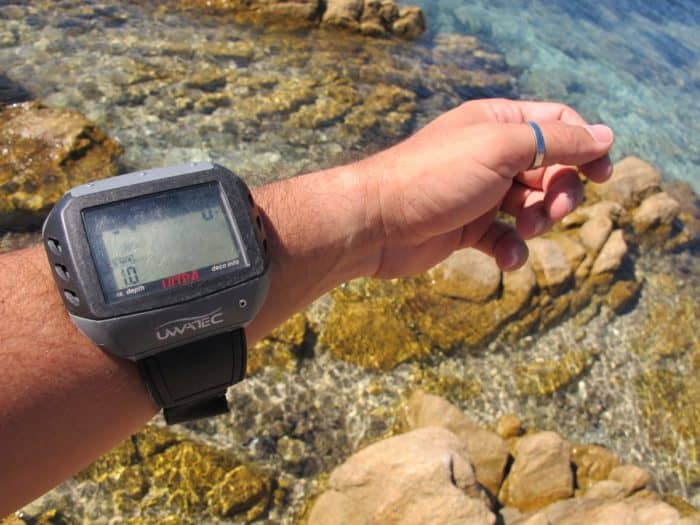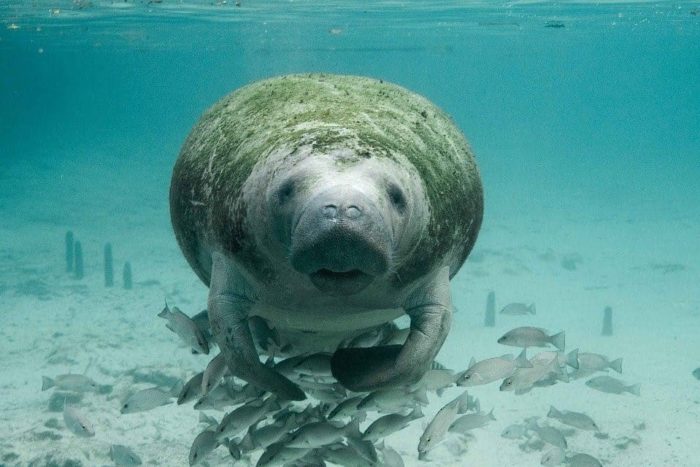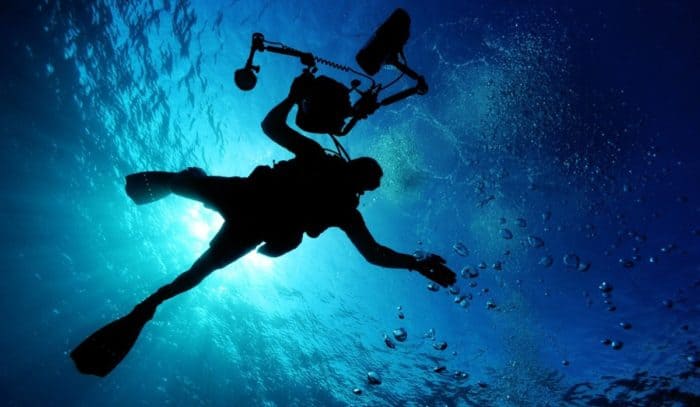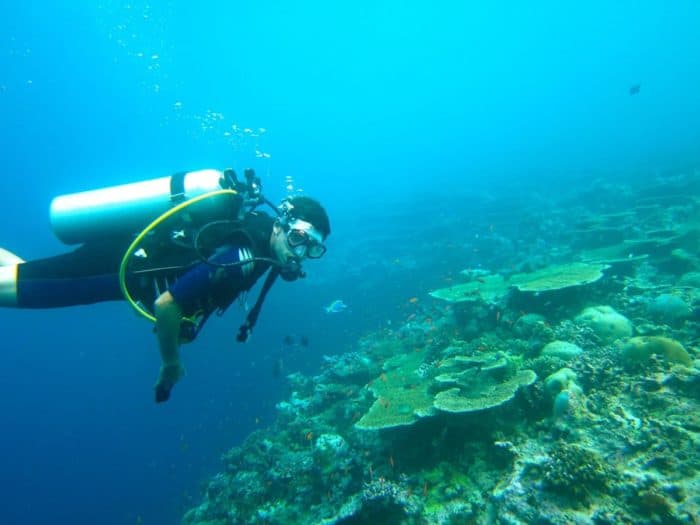How Water Pressure Works: Water Pressure Calculator Included
Most of us know that the deeper you go under water, the greater the pressure. This is why divers need to be careful as they come back up from deep dives. The nitrogen that has built up in their bodies needs time to dissipate. If this doesn’t happen, it expands too quickly. This gives rise to decompression sickness or “the bends.” Rapid decompression can even be deadly. So understanding pressure to depth and depth to pressure is important.
Let’s check out some of the basic things you should understand when it comes to understanding pressure underwater. Then we can check out to calculate depth to pressure.
What is Air Pressure or Atmospheric Pressure?
Some people will refer to atmospheric pressure as air pressure. Strictly speaking, atmospheric pressure is the better term to use. It refers to the pressure of the atmosphere around us, of which the air is a part. This is the weight of the air pressing down on the earth and everything on it.
So what even causes there to be pressure? Gravity. Even though the air seems like nothing to us, we know it’s made of atoms that have mass. The gravity of the earth is constantly pulling the air down and that is what creates that pressure around us. On other planets, ones that are far more dense with a greater gravity, the pressure on the surface could be enough to kill us.
When Does Air Pressure Have the Same Force as Your Internal Pressure?
When you’re at sea level, the air pressure pushes down on you at 14.7 lbs per square inch. This is the baseline for air pressure and you will not feel it at all. At sea level, the pressure inside your own body is pushing back on air pressure with the same force. This is basically a perfect equilibrium. If you go above sea level the pressure changes and you can feel it. That’s why at very high altitudes your ears will pop. Your body is balancing the pressure in your head at that point so you can still hear and not suffer damage.
Heading Below Sea Level
When a scuba diver goes underwater, the change in pressure becomes noticeable. Pressure and depth are intertwined. First, you’re dealing with water pressure and not just air pressure. Second, the pressure increases fairly quickly compared to air pressure on land.
Underwater you’re dealing with hydrostatic pressure. Hydrostatic is the liquid equivalent of atmospheric pressure. So, in this case, it’s the force exerted by a liquid on an object. The object in this case is a scuba diver and the pressure is the force acting on you.
At sea level, we experience 1 atmosphere of pressure. Underwater, the pressure increases by 1 atmosphere every 33 feet. One atmosphere is what we call that pressure we experience at sea level. In other words, one atmosphere equals 14.7 psi.
While you will experience 1 atmosphere every 33 feet, you experience .445 PSI every 1 foot in depth.
How Do Fish Survive Water Pressure?
Many marine animals can handle depths far greater than humans. In general, a human who wants to deep dive can go down to around 60 feet with no gear. Scuba divers can go to around 130 feet. The pressure of a dive is not necessarily a risk for you physiologically speaking. Your body is mostly fluid so the pressure can be managed for that. But the gases in your body become a problem. Most specifically nitrogen. The pressure on the nitrogen forces your body to store it in your cells. Your body only has so much room when it comes to storing nitrogen. It needs to be released at some point and it needs to be done safely. Otherwise decompression sickness is the result.
For sea life, this isn’t an issue. These creatures were made to stay underwater. The world record for a scuba dive with compressed air is just 390 feet. Unofficially, records exist for greater depths. Two thousand feet is the record for a diver using a specially designed dive suit intended to manage the terrible pressures at those depths. Modern submarines are believed to have crush depths around 3000 feet or so. The crush depth is the depth at which the hull of the vessel will literally collapse.
With that in mind, it’s worth noting that something called a Marianas snailfish was discovered living at 26,600 feet down. They experience pressure 2500 times what we do. The pressure they endure is around 15,000 psi. In fact, their bodies would fall apart if we brought them to the surface. They need the pressure to survive just like we need our relative lack of pressure to survive.
In general, marine life is better adapted to surviving pressure because of how their physiology works. They don’t breathe air like we do to have compressed gases in their systems. When you look at fish bones you can see that they’re far different than our own. Fish bones are much more like cartilage in humans. They are thin and flexible and are not at the same risk of breaking. Even those that do breathe air, like whales, are structured to manage pressure better. Their bodies are soft and their lungs actually collapse at depth to prevent gas exchange. The system works to allow them to handle pressures far greater than humans ever could.
How Much Pressure is at the Bottom of the Ocean?
Since we know how pressure increases in the ocean, you might be curious what that means in practical terms. How deep is the ocean anyway? Well, that’s not a single answer. Just like the surface of the earth is covered in peaks and valleys, so is the bottom of the ocean.
That Marianas snailfish we mentioned earlier lives at the deepest, darkest depths of the ocean. The Mariana Trench is the deepest part of the ocean mankind has ever discovered. It’s located in the Pacific Ocean and at its deepest point reaches over 36,000 feet. That’s over 6 miles.
The water pressure at this depth is 15,750 psi. However, as we said, that is the single deepest point. The rest of the oceans, which are vast, can vary greatly. The pressure tends to range between 3000 psi to 9000 psi depending on where you go. Obviously these are all far greater than any pressure a human and even most submarines can handle.
Specially made robots and submersibles have been built that can handle even the highest pressures the ocean has to offer. It takes these things around 4 hours just to get to the bottom of the trench from the surface.
Why Does Pressure Increase Underwater?
Just like with the air around us, the pressure of water increases as you are immersed. The thing about water is that you’re forcing yourself to go down into more of it. Thus, the pressure increases. At ground level you’re experiencing the pressure of all the air in the atmosphere all around you. As you increase altitude, the pressure will drop. There’s less air around you so less pressure. The water works the same but, obviously, in reverse. On the surface you have the least amount of pressure. As you go deeper you have the weight of all that water around you. It just increases the deeper you go until it becomes more than a human body can withstand. As we’ve seen, the pressure will eventually even become too great for something like a submarine once you go deep enough.
What is Decompression Sickness and the Bends?
Most people have heard the term “the bends” before and it’s not always clear what it means. Decompression sickness is the bends. The bends is just a slang term for it. So how does it work?
As we said, when you dive, nitrogen is stored in your cells. When you ascend from a dive you need to do so slowly. This is to allow the nitrogen to leave your body. The pressure at depth forced it into your cells. Now that the pressure is lessening, the nitrogen can expand. As you can imagine, if gas expanded rapidly into your body, it would be dangerous. That is the core of the bends or decompression sickness.
For a practical example, look at a bottle of soda or beer. When sealed, the liquid appears flat and ordinary. It’s under pressure. Now pop the top off. The pressure changes and bubbles rise to the surface. If the bottle has been shaken, you need to open it slowly to release the pressure. Otherwise it explodes. This is very similar to what happens inside the human body.
These bubbles of nitrogen will expand and form in your blood and joints. The name “the bends” is a direct reference to this. The bubbles in your joints cause them to bend. This can happen in your elbows, knees, wrists, back, etc. So the joints bend and it is painful to try to move them. Thus, a victim of the bends will be in a lot of pain and their body will appear to be bent in odd ways.
A slow and careful ascent is key to preventing decompression sickness. As you ascend, you take breaks. The nitrogen is allowed to filter through your system and you will exhale it as you breathe. Once you’ve achieved a balance at the new pressure where you have paused, you can ascend again. Depending on how deep you went down, this may need to happen several times.
What are the Symptoms of Decompression Sickness?
This condition is a lot worse than just bent joints. That’s the outward, physical sign of the condition. However, you may also suffer other side effects including:
- Serious muscle and joint point
- Tiredness
- Muscle weakness
- Headaches
- Confusion and lightheadedness
- Chest pains and difficulty breathing
- Dizziness and vertigo
- Double or blurry vision
The symptoms do not necessarily appear the instant you come out of the water. In fact, it can take upwards of an hour or even a day for them to appear. You may then start to feel dizzy and have trouble walking or staying conscious.
For mild cases, treatment usually involves breathing pure oxygen. You’ll need to go to a hospital so they can monitor you and get you on a breathing mask.
In serious cases, recompression therapy is used. This involves being sealed in a hyperbaric chamber where pressure is increased to about 3 times normal. If the situation is bad enough the side effects can be severe and also long lasting. The joint paint can last for a very long time, and won’t be alleviated right away. Worse, you could suffer long term neurological damage as well.
What is a No Decompression Limit?
The no-decompression limit is the amount of time a diver can spend at a given depth without needing to decompress. If a diver goes too deep or stays down too long, you’ll need to decompress on the way up. This number is not a constant by any means. It can change based on how deep you dive and even if you’ve been diving recently. That’s because all of these factors affect the nitrogen in your system.
Amateur divers need to be careful to avoid crossing these limits. If you don’t know how to safely decompress, this can be very dangerous. Divers should know how to calculate a no-decompression limit before they dive. A good dive computer can help.
If you exceed your limit, then the emergency decompression stops on ascent are necessary. One thing to remember is that this is not a problem. The word “emergency” makes it sound like something has gone wrong. That can lead some people to feeling anxious or panicky. There’s no reason, Plenty if divers do deep dives knowing full well they need to decompress on the way up. It’s just something you need to prepare for.
The only real emergency that should make you worry is related to breathing gases. If you exceed your no-decompression limit, you need to be able to breathe during those emergency decompression stops. If your time is way off and you are running low on air, this will be a problem. An emergency decompression stop should be around 3 to 5 minutes. If you don’t have the air to last that long, then you will suffer some consequences of not decompressing. That’s why planning is vital ahead of any dive. No one should ever be stuck in a situation where they have to choose decompression sickness.
Where Does Nitrogen Come From?
At this point you may be wondering where all this nitrogen is even coming from. Clearly it’s a danger to divers. It actually comes from the air in your tank when you’re diving. No one breathes pure oxygen and the compressed air in your tank is no exception. That said, not every gas mix is the same.
The most common mix is just called air or atmospheric air. This is the same as the air you’re breathing right now and is typically 21% oxygen and 78% nitrogen with a small amount of other gases included. The vast majority of the atmosphere around us is nitrogen and we breathe it all the time. It doesn’t harm us and, on the surface, we never need to worry about it saturating our tissue.
You can also breathe in more elaborate gas mixes designed to improve your performance as a scuba diver. This includes things like Nitrox mixes which have as much as 40% oxygen plus nitrogen in them. A Nitrox mix lets you dive longer because of the reduced nitrogen. However, you cannot dive as deeply.
Trimix blends are usually oxygen with reduced nitrogen and a third gas like helium. These allow divers to go to greater depths than normal. Like Nitrox, these are for skilled divers only.
Ironically, pure oxygen is actually very dangerous for divers. It can be used but only in rare circumstances and for very shallow divers. Pure oxygen is deadly if you try to breathe it at greater depths and pressures. A diver should not go below about 20 feet using pure oxygen.
So, as it relates to nitrogen, this is actually very normal. We breathe it in constantly. It’s just that the pressure on the gas forces it to stay in our bodies. In and of itself its presence is not unnatural inside of us, though.
Reasons to Stay Safe when Diving
Don’t forget, decompression sickness is just one way you can be harmed when diving. Nitrogen narcosis is also a risk factor. This is what happens when the pressure causes nitrogen to build up in your brain. It can make you feel and react like you’re drunk. This typically only happens on very deep dives of over 100 feet. The danger can be severe. Some victims have been so confused they removed their regulators because they felt they were safe to breathe.
Another thing to watch out for is barotrauma. This happens when pressure is not properly equalized. Sinuses, lungs, ears and other tissues near spaces that are typically filled with air can become damaged. This can rupture parts of your lungs. It can also lead to air bubbles forming in arteries, which can potentially cause a fatal embolism.
The Discovery of Decompression Sickness
As you can imagine, there had to be a few unlucky victims of decompression sickness before we figured out what was happening. There had been early experiments with pressure but the Brooklyn Bridge was one of the most vital steps. The bridge was built back in the 1870s. To do so, engineers used something called caissons. This was essentially a big metal tube forced down into the river. Compressed air was pumped unto the tube to force the water out. This allowed workers to enter the tube and dig the holes for the bridge’s foundation. So far so good. Except that the workers were now in a pressurized air environment.
Because no one understood how decompression worked, these men would go down and come right back up again. In time, they developed what came to be known as the bends. Painful joints, hunched over posture, and much worse. Some went blind and some even died.
They called the condition caisson sickness at first. It was in studying these victims that doctors were able to discover nitrogen bubbles in their blood.
Measuring Pressure to Depth
There is a formula you can use to determine pressure at depth. It does involve some constants that most of us are not likely to have memorized. Let’s take a look at the formula and then we can break it down.
P = pgh
P = pressure, which is what we’re trying to calculate.
Lowercase p = is the density of the water. This number can change! Specifically, there are two numbers here, one for saltwater and one for freshwater.
p(fresh) = 997.0474 kg/m^3
p(salt)= 1023.6 kg/m^3
Lowercase g = the acceleration of gravity. This is 9.8 m/s^2 and is a constant on Earth. If you were scuba diving on another planet you’d need to make adjustments, but obviously that’s not going to happen.
Lowercase h = the depth (height) of the fluid column. This number is one that must be determined by you as a diver.
An Example Calculation
Let’s do a simple one for a very shallow dive. You’re heading down 30 feet in saltwater.
P = (1023.6 kg/m^3) X (9.8 m/s^2) X 30 feet
P = 13.31 psi.
Obviously this is the kind of equation few of us will try to doodle on a scrap of paper ever. That’s why it’s good to have a calculator. You’re dealing with some complex numbers and it can get overwhelming.
The Faster Pressure Equation
So that last equation was pretty intense, right? Is there an easier way to gauge pressure? There is! Remember, we said earlier that every foot under water (we’re assuming saltwater here) is roughly .445 PSI. That makes it very easy to calculate a simple, rough idea of pressure under water. This one is much easier to do in your head or on the fly than the other one.
P = D x PSI
Pressure = Your Depth X PSI + 1 atmosphere
So let’s say you want to visit a wreck that’s at 42 feet below the surface.
P = 42 x .445
P = 18.69 + 14.7
P = 33.39
Don’t forget to add the 14.7 to the total pressure. That’s the atmospheric pressure exerted at sea level, and that needs to be added onto any measurement of pressure below the surface as well. You can see that, at 42 feet, you’re going to experience a bit over 2 atmospheres of absolute pressure.
Why is the Pressure of Saltwater Different Than Freshwater?
As you can see in the above equation, saltwater has a different density than freshwater. That means pressure needs to be calculated slightly differently. The reason is the salt itself. Because saltwater has salt dissolved in it, the water is now more dense. That means if you fill a bottle with saltwater and the same sized bottle with freshwater, the saltwater bottle is going to weigh more. And, if you’re diving, you will experience a greater pressure in saltwater as a result.
Water temperature also has an effect on density. Things expand when they are warm and contract in the cold. That’s why warm water is less dense than cold water. And of course warm water is typically only found near the surface where the sun is able to warm it up. At the deepest depths of the ocean, water is only a few degrees above freezing.
The Bottom Line
Humans were never meant to spend a lot of time under water. Things work differently down there but luckily we have managed to adapt. Make sure you understand how water pressure works if you plan on diving so you know what you can handle and for how long.
Categories: Scuba, Tools and Calculators
